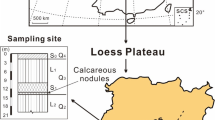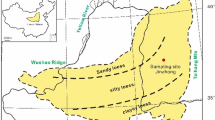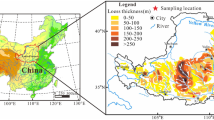Abstract
Loess soils are characterized by metastable microstructure, high porosity and water-sensitivity. These soils have always been problematic soils and attracted attention from researchers all over the world. In the present study, three loess soils extracted at various depths from the Loess Plateau of China, i.e. Malan (Q3), upper Lishi (Q22) and lower Lishi (Q21) loess soils, were studied. Single oedometer-collapse tests were performed on intact loess specimens to investigate the collapse behavior of three loess soils. The microstructure and chemical composition of each loess before and after collapse test were characterized using scanning electron microscopy (i.e. SEM) and energy dispersive spectroscopy (i.e. EDS) techniques. The microstructural evolution due to wetting collapse was interpreted qualitatively and quantitatively in terms of the pore morphology properties. The results suggest that: ① the collapse potential of each loess may rise again after a round of rise and drop, which could be failure of the new-developed stable structure under quite high vertical pressure. It implies that loess may collapse even if it has collapsed. ② Q3, Q22 and Q21 loess have different types of microstructure, namely, granule, aggregate and matrix type of microstructure, respectively. ③ The microstructural evolution due to loading and wetting is observed from a granule type to an aggregate type and finally to a matrix type of structure. The variations in distributions of pore morphology properties indicate that collapse leads to a transformation of large-sized pores into small-sized pores, re-orientation and remolding of soil pores due to particle rearrangement. ④ A porous structure is essential for loess collapse; however, the non-water-stability of bonding agents promotes the occurrence of collapse under the coupling effect of loading and wetting.
Similar content being viewed by others
References
ASTM (2006) Annual book of ASTM standards. ASTM International, West Conshohocken, Pennsylvania, United States.
Barden L, McGown A, Collins K (1973) The collapse mechanism in partly saturated soil. Engineering Geology 7 (1): 49–60. https://doi.org/10.1016/0013-7952(73)90006-9
Chen ZH, Xu ZH, Liu ZD (1986) Some problems on the collapse of collapsible loess. China Civil Engineering Journal 19 (3): 86–94. (In Chinese)
Chen ZH, Fredlund DG, Gan JK (1999) Overall volume change, water volume change, and yield associated with an unsaturated compacted loess. Canadian Geotechnical Journal 36 (2): 321–329. https://doi.org/10.1139/t98-097
Chen ZH, Fang XW, Zhu YQ, et al. (2009) Research on Mesostructures and Their Evolution Laws of Expansive Soil and Loess. Rock and Soil Mechanics 30 (1): 1–11. (In Chinese)
Delage P, Lefebvre G (1984) Study of the structure of a sensitive Champlain clay and of its evolution. Canadian Geotechnical Journal 21 (1): 21–35. https://doi.org/10.1139/t84-003
Derbyshire E, Mellors TW (1988) Geological and geotechnical characteristics of some loess and loessic soils from China and Britain: A comparison. Engineering Geology 25 (2): 135–75. https://doi.org/10.1016/0013-7952(88)90024-5
Derbyshire E (2001) Geological hazards in loess terrain, with particular reference to the loess regions of China. Earth Science Review 54 (1): 231–60. https://doi.org/10.1016/S0012-8252(01)00050-2
Dijkstra TA, Rogers CDF, Smalley IJ, et al. (1994) The loess of northcentral China: geotechnical properties and their relation to slope stability. Engineering Geology 36 (3-4): 153–171. https://doi.org/10.1016/0013-7952(94)90001-9
Duan Z, Peng JB, Wang QY (2016) Characteristic parameter and formation mechanism of repeatedly failure loess landslides. Journal of Mountain Science 34 (1): 71–76. (In Chinese)
Fan XF, Xu Q, Scaringi G, et al. (2017) A chemo-mechanical insight into the failure mechanism of frequently occurred landslides in the loess plateau, Gansu province, China. Engineering Geology 228. http://doi.org/10.1016/j.enggeo.2017.09.003
Gao GR (1980) Classification for microstructure of loess and its collapsibility. Chinese Science Bulletin (12): 1203–12. (In Chinese)
Guan WZ (1989) The collapse types and characteristics of loess in Xi’an and Lanzhou. Journal of Guilin College of Geology 9 (1): 74–80. (In Chinese)
Handy RL (1973) Collapsible loess in Lowa. Soil Science Society of America Journal 37 (2): 281–284. http://doi.org/10.2136/sssaj1973.03615995003700020033x
Hu RL, Guan GL, Li XQ, et al. (1999) Microstructure effects on the subsidence of loess. Journal of Engineering Geology 7 (2): 161–167. (In Chinese)
Jiang MJ, Zhang FG, Hu HJ, et al. (2014) Structural characterization of natural loess and remoulded loess under triaxial tests. Engineering Geology 181: 249–60. http://doi.org/10.1016/j.enggeo.2014.07.021
Jiang MJ, Li T, Thornton C, et al. (2016) Wetting-induced collapse behavior of unsaturated and structural loess under biaxial tests using distinct element method. International Journal of Geomechanics, 06016010. http://doi.org/10.1061/(ASCE)GM.1943-5622.0000693
Lei XY (1987) Pore types of loess soils in China and its collapsibility. Chinese Science (B section) (12): 1310–1316 (In Chinese).
Li P, Vanapalli SK, Li TL (2016) Review of collapse triggering mechanism of collapsible soils due to wetting. Journal of Rock Mechanics and Geotechnical Engineering 8: 256–274. http://doi.org/10.1016/j.jrmge.2015.12.002
Li Y, Zhang T, Zhang YB, et al. (2018) Geometrical appearance and spatial arrangement of structural blocks of the Malan loess in nw china and the implications for the formation of loess columns. Journal of Asian Earth Sciences, 158: 18–28. https://doi.org/10.1016/j.jseaes.2018.02.007
Liu Z, Liu FY, Ma FL, et al. (2016) Collapsibility, composition, and microstructure of loess in China. Canadian Geotechnical Journal 53 (4): 673–686. https://doi.org/10.1139/cgj-2015-0285
Lutenegger AJ, Saber RT (1988) Determination of collapse potential of soils. Geotechnical Testing Journal 11 (3): 173–178.
Luo H, Wu FQ, Chang JY, et al. (2018) Microstructural constraints on geotechnical properties of Malan loess: a case study from Zhaojiaan landslide in Shaanxi province, China. Engineering Geology 236: 60–69. https://doi.org/10.1016/j.enggeo.2017.11.002
Miao TD, Wang ZG (1990) Deformation mechanism of collapsible loess considering microstructure instability. Science in China (Series B) 1990 (1): 86–96. (In Chinese)
Momeni M, Shafiee A, Jafari MK, et al. (2012) Evaluation of soil collapse potential in regional scale. Natural Hazards 64 (1): 459–479. http://doi.org/10.1007/s11069-012-0252-z
Ng CWW, Sadeghi H, Hossen SB, et al. (2016) Water retention and volumetric characteristics of intact and re-compacted loess. Canadian Geotechnical Journal 53: 1258–1269. http://doi.org/10.1139/cgj-2015-0364
Rogers CDF, Dijkstra TA, Smalley IJ (1994) Hydroconsolidation and subsidence of loess: studies from China, Russia, North America and Europe. Engineering Geology 37: 83–113. https://doi.org/10.1016/0013-7952(94)90045-0
Shao XX, Zhang HY, Tan Y (2018) Collapse behavior and microstructural alteration of remolded loess under graded wetting tests. Engineering Geology 233: 11–22. https://doi.org/10.1016/j.enggeo.2017.11.025
Tan T (1988) Fundamental properties of loess from northwestern China. Engineering Geology 25 (2-4): 103–122. https://doi.org/10.1016/0013-7952(88)90022-1
Wen BP, Yan YJ (2014) Influence of structure on shear characteristics of the unsaturated loess in lanzhou, china. Engineering Geology 168 (1): 46–58. http://doi.org/10.1016/j.enggeo.2013.10.023
Xie X, Qi SW, Zhao FS, et al. (2018a) Creep behavior and the microstructural evolution of loess-like soil from xi'an area, china. Engineering Geology 236: 43–59. https://doi.org/10.1016/j.enggeo.2017.11.003
Xie WL, Li P, Vanapalli SK, et al. (2018b) Method for predicting the wetting-induced collapse behavior using the soil-water characteristic curve as a tool. Journal of Asian Earth Science 151: 259–268. https://doi.org/10.1016/j.jseaes.2017.11.009
Xu L, Dai FC,Kwong AKL, et al. (2008) Types and characteristics of loess landslides at Heifangtai loess plateau, China. Journal of Mountain Science 26 (3): 364–371. (In Chinese)
Xu L, Coop MR (2016) Influence of structure on the behavior of a saturated clayey loess. Canadian Geotechnical Journal 53 (6): 1026–1037. http://doi.org/10.1139/cgj-2015-0200
Xu L, Coop MR, Zhang MS, et al. (2018) The mechanics of a saturated silty loess and implications for landslides. Engineering Geology 236 (26): 29–42. http://doi.org/10.1016/j.enggeo.2017.02.021
Yang YL (1988) Study on collapsible mechanism of loess soils. Science in China (Series B) 7: 756–766. (In Chinese)
Zhang FY, Wang GH, Kamai T, et al. (2013) Undrained shear behavior of loess saturated with different concentrations of sodium chloride solution. Engineering Geology 155 (6): 69–79. https://doi.org/10.1016/j.enggeo.2012.12.018
Zhang FY, Wang GH (2018) Effect of irrigation-induced densification on the post-failure behavior of loess flowslides occurring on the Heifangtai area, Gansu, China. Engineering Geology 236 (26): 111–118. https://doi.org/10.1016/j.enggeo.2017.07.010
Zhang MH, Xie YL, Liu BJ (2005) Characteristics of collapsibility coefficient curves of loess during moistening and demoistening process. Rock & Soil Mechanics 26 (9): 1363–1368. (In Chinese)
Zhu YQ, Chen ZH (2009) Experimental study on dynamic evolution of meso-structure of intact Q3 loess during loading and collapse using CT and triaxial apparatus. Chinese Journal of Geotechnical Engineering 31 (8): 1219–1228. (In Chinese)
Acknowledgements
Authors acknowledge the National Key Research and Development Program of China (2017YFD0800501), the National Natural Science Foundation of China (Grant No. 41772323), the Shaanxi Science and Technology Bureau (Grant No. 2016KW-030),the Geological Survey Bureau of China (DD20189270), the Key Laboratory for Geohazard in Loess Area, Ministry of Land and Resources (Grant No. KLGLAMLR201502) 。
Author information
Authors and Affiliations
Corresponding author
Rights and permissions
About this article
Cite this article
Xie, Wl., Li, P., Zhang, Ms. et al. Collapse behavior and microstructural evolution of loess soils from the Loess Plateau of China. J. Mt. Sci. 15, 1642–1657 (2018). https://doi.org/10.1007/s11629-018-5006-2
Received:
Revised:
Accepted:
Published:
Issue Date:
DOI: https://doi.org/10.1007/s11629-018-5006-2




